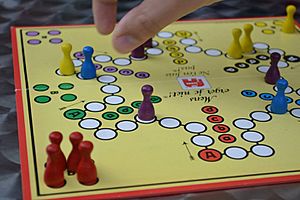Mensch ärgere Dich nicht facts for kids
 |
|
| Designer(s) | Josef Friedrich Schmidt |
|---|---|
| Publisher(s) | Schmidt Spiele |
| Publication date | 1914 |
| Genre(s) | Board game |
| Language(s) | German |
| Players | 2 to 4 (2 to 6 on reverse side) |
| Setup time | 1 minute |
| Playing time | about 30 minutes |
| Random chance | High (die rolling) |
| Skill(s) required | Counting, probability |
Mensch ärgere Dich nicht (English: Man, Don't Get Angry) is a German board game (but not a German-style board game), developed by Josef Friedrich Schmidt in 1907/1908. Some 70 million copies have been sold since its introduction in 1914 and it is played in many European countries.
The name derives from the fact that a peg is sent back to the "out" field when another peg lands on it, similar to the later game Sorry!. It is a cross and circle game with the circle collapsed onto the cross, similar to the Indian game Pachisi, the Colombian game Parqués, the American games Parcheesi and Trouble, and the English game Ludo.
Overview
The most played variant of the game can be played by 2, 3, 4 players – one player per board side. The special one has a pattern for 6 players. Each player has four game pieces, which are in the "out" area when the game starts, and which must be brought into the player's "home" row.
The rows are arranged in a cross position. They are surrounded and connected with a circle of fields, over which the game pieces move in clockwise direction. There are three fields on each side of the board. At the beginning of the game, the players' pieces are placed in the four fields marked "B" on the far left side, the "out" section. The coloured field just left of centre, marked "A", is each player's "start" field. The white field just to the right of the start field leads to the "home" row, marked "a", "b", "c", "d". Each game piece enters the circle at the "start" field ("A"), moves (clockwise) over the board and finally enters the "home" row. The first player with all of their pieces in their "home" row wins the game.
The players throw game dice in turn and can advance any of their pieces in the game by the thrown number of dots on the die.
Throwing a six means bringing a piece into the game (by placing one from the "out" ("B") area onto the "start" or "A" field) and throwing the dice again. If a piece is on the "A" field and there are still pieces in the "out" area, it must be moved as soon as possible. If a piece cannot be brought into the game then any other piece in the game must be moved by the thrown number, if that is possible. A commonly played variation allows a player who has no pieces in the circle of fields to have three tries to throw a six.
Pieces can jump over other pieces, and throw out pieces from other players (into that player's "out" area) if they land on them. A player cannot throw out his own pieces, though he can advance further than the last field in the "home" row. A player can be thrown out if he is on his "start" field.
Versions
There is another version of the game called Verliere nicht den Kopf (Don't lose your head) based on the same game mechanism as the original one. There are, however, two defining differences: whenever the player proceeds to any of the corner squares, they can take a diagonal shortcut for their next move to save half the trip. This way, every player can use two spots for shortcuts. However, to get to the finish line, all of the squares need to be reached by rolling the dice to get the exact number (first piece placed on the last square, second one on the second to the last etc). The original version allows the player to move the tokens within the finish area, if the roll is low enough. As a result, the piece remains in the game longer before it reaches the finish line, which increases the risk of being kicked out.
See also
 In Spanish: Mensch ärgere Dich nicht para niños
In Spanish: Mensch ärgere Dich nicht para niños


